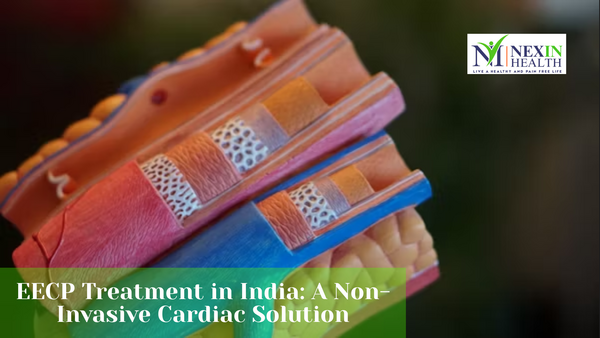Notifications
ALL BUSINESS
COMIDA
DIRECTORIES
ENTERTAINMENT
FINER THINGS
HEALTH
MARKETPLACE
MEMBER's ONLY
MONEY MATTER$
MOTIVATIONAL
NEWS & WEATHER
TECHNOLOGIA
TV NETWORKS
VIDEOS
VOTE USA 2026/2028
INVESTOR RELATIONS
COMING 2026 / 2027
ALL BUSINESS
COMIDA
DIRECTORIES
ENTERTAINMENT
FINER THINGS
HEALTH
MARKETPLACE
MEMBER's ONLY
MONEY MATTER$
MOTIVATIONAL
NEWS & WEATHER
TECHNOLOGIA
TV NETWORKS
VIDEOS
VOTE USA 2026/2028
INVESTOR RELATIONS
COMING 2026 / 2027
 Nexin Health -
4 hours ago -
Health -
eecp treatment in india
eecp treatment
-
10 views -
0 Comments -
0 Likes -
0 Reviews
Nexin Health -
4 hours ago -
Health -
eecp treatment in india
eecp treatment
-
10 views -
0 Comments -
0 Likes -
0 Reviews

When you’re undergoing EECP therapy for heart health, your diet plays a much bigger role than most people realize. While EECP (Enhanced External Counter Pulsation) itself improves blood flow and helps the heart function better, nutrition works silently in the background to support, accelerate, and sustain those improvements.
In India, where diets are diverse and rich in both healing and harmful elements, what you eat during and after EECP can dramatically affect how well you recover—and how long the benefits last.
In this blog, we’ll explore how EECP treatment in India works hand-in-hand with proper nutrition to support heart health, enhance blood flow, and create long-term vascular wellness.
EECP is a non-invasive therapy designed to improve blood circulation.
It uses external cuffs placed around your legs
These inflate and deflate in rhythm with your heartbeat
This pushes blood back toward your heart
Over time, new pathways (collateral circulation) are developed
Oxygen delivery improves, chest pain reduces, and heart function strengthens
It’s often recommended for:
Stable angina
Heart failure
Poor exercise tolerance
Post-bypass or post-stent recovery
High-risk patients unfit for surgery
But while EECP improves blood flow mechanically, diet improves it biochemically.
Your body is forming new blood vessels and reducing inflammation during EECP. That process is supported and strengthened when your diet:
Reduces blood viscosity (thickness)
Lowers inflammation
Controls blood sugar and pressure
Provides antioxidants and nutrients for vascular repair
Supports healthy cholesterol levels
A poor diet can actually slow or limit EECP’s full potential. A good one enhances it.
Some foods improve circulation by:
Relaxing blood vessels
Enhancing nitric oxide production
Preventing clot formation
These include:
Beets
Garlic
Turmeric
Green leafy vegetables
Amla (Indian gooseberry)
Dark chocolate (in moderation)
EECP improves circulation, but chronic inflammation can interfere with its benefits. Reduce inflammation through:
Omega-3 rich foods like flaxseed, walnuts, chia seeds
Fresh fruits (especially berries, pomegranate, and oranges)
Minimizing fried and ultra-processed items
High sugar and salt levels can undo the vascular benefits of EECP. Aim for:
Low glycemic index carbs: brown rice, millets, oats
Avoiding refined flours (maida), excess sweets
Using herbs like cinnamon and fenugreek to control glucose
Limiting table salt and using rock salt in moderation
The inner lining of your blood vessels (endothelium) benefits from:
Vitamin C: citrus fruits, amla, capsicum
Vitamin E: sunflower seeds, almonds
Polyphenols: green tea, turmeric, berries
Magnesium: bananas, spinach, pumpkin seeds
Healthy endothelium = better vessel flexibility and blood flow.
Warm water with lemon
Handful of soaked almonds or walnuts
Herbal tea (tulsi, cinnamon, or ginger)
Oats porridge with banana slices and chia seeds
OR
Multigrain dosa with tomato chutney and one boiled egg white
Fresh fruit (guava, apple, or papaya)
1 glass buttermilk or coconut water
1 medium bowl brown rice or 2 phulkas
Dal or rajma (cooked with less oil and salt)
Stir-fried spinach or bottle gourd
Curd (plain)
Fresh salad with carrot, cucumber, beetroot
Roasted chana or foxnuts (makhana)
Green tea
Clear vegetable soup
1 millet roti + lightly spiced paneer or tofu
Steamed vegetables
Warm turmeric milk (low fat)
1 date (if sugar is controlled)
Even if you eat well, certain items can cancel out EECP benefits. Limit or avoid:
Deep fried snacks (samosas, pakoras, chips)
Sugary desserts (gulab jamun, cakes, sweetened juices)
Refined carbs (white bread, maida-based items)
Excess red meat or processed meats
High-sodium pickles, papads, processed chutneys
Smoking and alcohol—these damage blood vessels rapidly
Good circulation needs adequate fluid volume in your blood. Dehydration thickens blood, increasing the heart’s workload.
Drink:
8–10 glasses of water daily
Coconut water or herbal infusions
Avoid sugary colas or high-caffeine energy drinks
Use low glycemic grains (millets, oats)
Avoid fruit juices; eat whole fruits
Snack on sprouts or roasted chana instead of biscuits
Use less salt while cooking
Add herbs (garlic, ajwain, amla) for flavor and pressure control
Softer foods like khichdi, cooked vegetables
Easily digestible proteins (curd, dal, paneer)
Small, frequent meals to prevent bloating or weakness
Nexin Health takes a comprehensive approach to EECP therapy. In addition to treatment, patients receive:
Dietary assessments at the start of the program
Customized meal plans based on health status
Guidance on Indian superfoods for heart health
Ongoing lifestyle coaching to support weight, sugar, and pressure control
This ensures that the vascular improvements from EECP are supported by what you eat every day—making results stronger and longer-lasting.
Yes, but with modifications—less oil, less salt, more fiber, and whole ingredients.
Not necessarily. Lean meats like fish or boiled chicken can be included if tolerated. But avoid red meat and fried non-veg dishes.
Yes, in moderation. Bananas are good for potassium. Mangoes are fine in small amounts if your sugar is controlled.
Not if it’s brown or red rice. Portion control is key. You can alternate with millets like bajra, jowar, and ragi.
EECP is one of the most effective non-surgical treatments to improve heart circulation—but it doesn’t work in isolation. What you eat every day during therapy plays a powerful role in determining:
How well your body forms new blood vessels
How efficiently blood flows through them
How stable your blood pressure and sugar remain
How long the benefits of EECP last
With the right nutrition, you can maximize every session of therapy and reduce your long-term cardiac risk.
